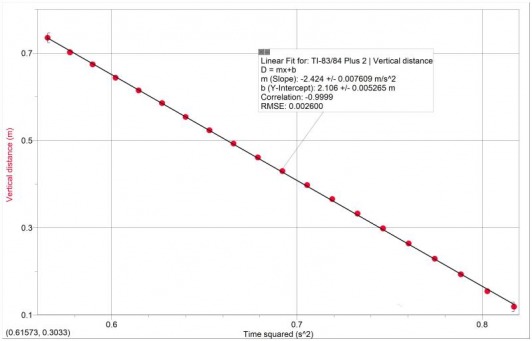Purpose:
· Measure the translational acceleration of a object falling from a pulley (as illustrated in the figure below), and
· Use the measured acceleration to analyze the validity of assumption that the pulley exhibits rotational inertia consistent with a disk (I = ½ MR2).
· Use the measured acceleration to analyze the validity of assumption that the pulley exhibits rotational inertia consistent with a disk (I = ½ MR2).
Equiptment:
Pulley, hanging mass, motion detector with CBL data acquisition system.
Procedure:
We constructed a pulley and dropped a mass from the pulley to the ground. We tied our weight to a string which we tied to the pulley. Our string was, when fulley extended, about 113 cm. We set up a motion director below the weight in order to create an accurate graph.
Ic = calculated Inertia
m = mass = .097 kg
r = radius = .0183 m
g = acceleration due to gravity = -9.8
At = tangental acceleration = slppe from best fit line * 2 = -2.424 *2 = -4.848
Ic = (mgr^2/At)
Ic = [(.097 kg)(-9.8)(.0183^2)/(-4.848)] = 6.566 x 10^-5
Id = inertia of the disk
Mp = mass of the pulley = .0132 kg
Rp = radius of the pulley = .0183 m
Id = (1/2)(Mp)(Rp)^2
Id = (1/2)(.0375 kg)(.0183^2) = 2.21 x 10^-6
Percent Difference = %D =(Id - Ic)/[(Id+Ic)/2] x 100
%D = [(2.21 x 10^-6) - (6.566 x 10^-5)] / [(2.21 x 10^-6 + 6.566 x 10^-5)/2] x 100
%D = -1.8697 x 100 = -186.97
Ic = calculated Inertia
m = mass = .097 kg
r = radius = .0183 m
g = acceleration due to gravity = -9.8
At = tangental acceleration = slppe from best fit line * 2 = -2.424 *2 = -4.848
Ic = (mgr^2/At)
Ic = [(.097 kg)(-9.8)(.0183^2)/(-4.848)] = 6.566 x 10^-5
Id = inertia of the disk
Mp = mass of the pulley = .0132 kg
Rp = radius of the pulley = .0183 m
Id = (1/2)(Mp)(Rp)^2
Id = (1/2)(.0375 kg)(.0183^2) = 2.21 x 10^-6
Percent Difference = %D =(Id - Ic)/[(Id+Ic)/2] x 100
%D = [(2.21 x 10^-6) - (6.566 x 10^-5)] / [(2.21 x 10^-6 + 6.566 x 10^-5)/2] x 100
%D = -1.8697 x 100 = -186.97
Data:
Data Analysis:
Based on the best fit equation on the graph, the relationship between vertical distance and time squared is a linear equation. This means that as the weight drops lower the time increases. Nothing increases exponentially or reverses directions which makes the graph so clean.
Conclusion:
In the experiment, many things were recorded using the motion detector. This gave us the majority of our numbers. Our percent error was nearly 187%. Something went wrong, probably in the way we ran our experiment. The motion detector may have been set up incorrectly or we may have miscalculated masses, or other numbers. Even with the huge percent error, we realized that the relationship between distance and time was linear based on the graph and how the inertia comes into play in a rotational motion lab.

